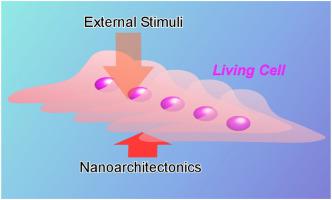Materials Today Bio ( IF 8.2 ) Pub Date : 2020-09-11 , DOI: 10.1016/j.mtbio.2020.100075 Jingwen Song 1 , Xiaofang Jia 2 , Katsuhiko Ariga 1, 2

|
The living cell can be regarded as an ideal functional material system in which many functional systems are working together with high efficiency and specificity mostly under mild ambient conditions. Fabrication of living cell–like functional materials is regarded as one of the final goals of the nanoarchitectonics approach. In this short review article, material-based approaches for regulation of living cell behaviors by external stimuli are discussed. Nanoarchitectonics strategies on cell regulation by various external inputs are first exemplified. Recent approaches on cell regulation with interfacial nanoarchitectonics are also discussed in two extreme cases using a very hard interface with nanoarchitected carbon arrays and a fluidic interface of the liquid-liquid interface. Importance of interfacial nanoarchitectonics in controlling living cells by mechanical and supramolecular stimuli from the interfaces is demonstrated.
中文翻译:

响应性细胞生物系统的界面纳米结构
活细胞可以被视为一种理想的功能材料系统,其中许多功能系统大多在温和的环境条件下高效、专一地协同工作。制造类活细胞功能材料被认为是纳米建筑学方法的最终目标之一。在这篇简短的评论文章中,讨论了通过外部刺激调节活细胞行为的基于材料的方法。首先举例说明了通过各种外部输入进行细胞调节的纳米结构策略。最近使用界面纳米结构进行细胞调节的方法也在两种极端情况下进行了讨论,使用具有纳米结构碳阵列的非常硬的界面和液-液界面的流体界面。界面纳米结构在通过界面的机械和超分子刺激控制活细胞方面的重要性得到了证明。


























 京公网安备 11010802027423号
京公网安备 11010802027423号